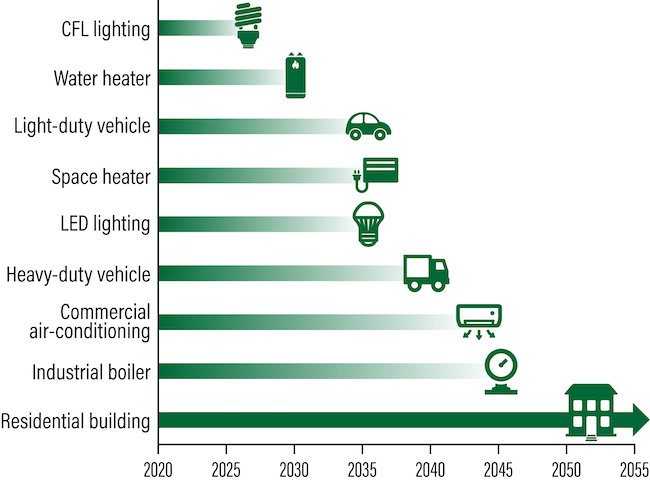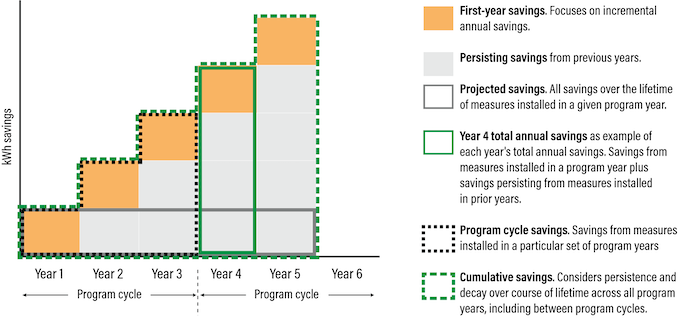An increasing number of states are finding new ways to track and value energy savings over time, according to research published today. Energy efficiency savings can accrue over many years, but most policies focus only on the first year. Our report, Energy Efficiency Over Time: Measuring and Valuing Lifetime Energy Savings in Policy and Planning, explores recent state efforts to take a longer view and the challenges they face when policies track only short-term savings.
Energy efficiency offers a family tree of options for customers, from the “grandparents” – investments in efficient new construction that can last more than 40 years – to more youthful air conditioning filter replacements that last just a few months. Because of this range in lifetimes, energy efficiency can provide varying values in resource planning, climate policy, and investment decisions.
Typical lifetimes of savings from various measures installed or implemented in 2020.
So far, policies have generally focused on first-year savings, because this approach makes it easier to describe, measure, and plan programs. These policies may unintentionally favor measures with high first-year savings, some of which may not continue to deliver savings over a long time. However, a focus on first-year savings does not easily translate to resource planning and climate investment, settings where long-term impacts are important. The right mix of first-year and lifetime policies in cost-effectiveness testing, goals, incentives, and resource planning may vary from state to state based on other policy priorities like equity and bill impacts.
States are starting to experiment with new ways to value savings over time, and evaluators are providing better estimates of such savings. We see this emerging in two main areas: designing program administrator incentives and goal setting.
Setting Goals
State Efficiency Resource Standards (EERS), bedrock policies for saving energy, are evolving in jurisdictions around North America. Below we illustrate a few of the emerging approaches for tracking savings over time.
Some states, including Illinois, value all the savings in a given year, plus remaining savings from measures installed in prior years. Other areas, including the Canadian province of Ontario, project savings forward. Additional strategies include setting minimum lifetime goals for a whole portfolio, accounting for savings within a given program cycle, or adjusting cost-effectiveness testing to better value energy efficiency and energy savings over time.
While these policies have transaction and tracking costs, early evidence shows that lifetime-oriented EERS better align with resource planning and encourage a longer-term perspective for energy efficiency investment.
Business Model Incentives
Twenty-nine states have performance incentives to encourage utilities to invest in energy efficiency for their customers. Michigan and Illinois have recently begun to structure incentives that explicitly encourage investment in longer-term measures by tying eligibility or awards to savings over time. These changes draw stakeholder attention to the lifetime of efficiency. However, explicit lifetime incentives are rare, and most states encourage first-year savings, or support lifetime savings only implicitly through incentive award calculations based on the net present value of benefits (which takes into account the time-value of those benefits).
Measuring Savings
To understand and track the value of energy efficiency over time, decision makers need good estimates of how long measures and programs last. For some measures, savings decline over time if they’re not maintained well; for others, savings may grow over time when paired with strong energy-management strategies. But studies of these factors are uncommon, both because they’re less important for first-year goals and because they can be expensive. However, researchers in Ontario, Illinois, and California are gathering data to improve lifetime estimates and devising new ways to prioritize evaluation research.
Our paper finds that new measurement and policy options help encourage the whole family tree of energy efficiency options, from youthful operational and behavioral programs to LED teenagers to elderly building envelope measures. We’re eager to see states and utilities maximize use of energy efficiency over time by continuing to better align their energy efficiency policies with their planning and climate objectives.




